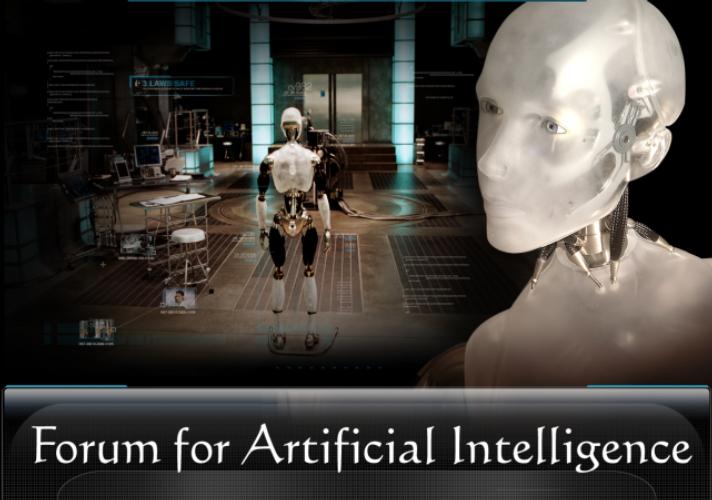
About FAI
|
The Forum for Artificial Intelligence meets every other week (or so) to discuss scientific, philosophical, and cultural issues in artificial intelligence. Both technical research topics and broader inter-disciplinary aspects of AI are covered, and all are welcome to attend! If you would like to be added to the FAI mailing list, or have any questions or comments, please send email to Manish Saggar or Joseph Reisinger . |
Upcoming talks
| Thursday, September 11 3pm, TAY 3.128 |
Chad Jenkins Brown University |
Learning in Human-Robot Teams |
| Friday, September 12 11:00am, TAY 3.128 |
Jesse Davis University of Washington |
Statistical Relational Learning, Diagnosing Breast Cancer and Transfer Learning |
Thursday, September 11, 3:00pm
|
Learning in Human-Robot TeamsChad Jenkins [homepage]
A principal goal of robotics is to realize embodied systems that are effective collaborators for human endeavors in the physical world. Human-robot collaborations can occur in a variety of forms, including autonomous robotic assistants, mixed-initiative robot explorers, and augmentations of the human body. For these collaborations to be effective, human users must have the ability to realize their intended behavior into actual robot control policies. At run-time, robots should be able to manipulate an environment and engage in two-way communication in a manner suitable to their human users. Further, the tools for programming, communicating with, and manipulating using robots should be accessible to the diverse sets of technical abilities present in society.
About the speaker:Odest Chadwicke Jenkins, Ph.D., is an Assistant Professor of Computer Science at Brown University. Prof. Jenkins earned his B.S. in Computer Science and Mathematics at Alma College (1996), M.S. in Computer Science at Georgia Tech (1998), and Ph.D. in Computer Science at the University of Southern California (2003). In 2007, he received Young Investigator funding from the Office of Naval Research and the Presidential Early Career Award for Scientists and Engineers (PECASE) for his work in learning primitive models of human motion for humanoid robot control and kinematic tracking. |
Friday, September 12, 11:00am
|
Statistical Relational Learning, Diagnosing Breast Cancer and Transfer LearningDr. Jesse Davis [homepage]
Standard inductive learning makes two key assumptions about the structure of the data. First, it requires that all examples are independent and identically distributed (iid). Second, it requires that the training and test instances come from the same distribution. Decades of research have produced many sophisticated techniques for solving this task. Unfortunately, in real applications these assumptions are often violated. In the first part of this talk, I will motivate the need to handle non-iid data through the concrete task of predicting whether an abnormality on a mammogram is malignant. I will describe the SAYU algorithm, which automatically constructs relational features. Our system makes significantly more accurate predictions than both radiologists and other machine learning techniques on this task. Furthermore, we identified a novel feature that is indicative of malignancy. In the second part of this talk, I will discuss a transfer learning algorithm that removes both restrictions made by standard inductive learners. In shallow transfer, test instances are from the same domain, but have a different distribution. In deep transfer, test instances are from a different domain entirely (i.e., described by different predicates). Humans routinely perform deep transfer, but few learning systems are capable of it. I will describe an approach based on a form of second-order Markov logic, which discovers structural regularities in the source domain in the form of Markov logic formulas with predicate variables, and instantiates these formulas with predicates from the target domain. Using this approach, we have successfully transferred learned knowledge between a molecular biology domain and a Web one. The discovered patterns include broadly useful properties of predicates, like symmetry and transitivity, and relations among predicates, like various forms of homophily. About the speaker:Jesse Davis is a post-doctoral researcher at the University of Washington. He received his Ph.D in computer science at the University of Wisconsin - Madison in 2007 and a B.A. in computer science from Williams College in 2002. His research interests include statistical relational learning, transfer learning, inductive logic programming and data mining for biomedical domains. |
Past talks
| Monday, August 25 3:00pm, PAR 301 |
Alexander Koller Saarland University |
Generation as planning |
| Friday, August 29 11:00am, ACES 2.402 |
Sameer S. Pradhan BBN Technologies |
OntoNotes: A Unified Relational Semantic Representation |
Monday, August 25, 3:00pm
|
Generation as planningAlexander Koller [homepage]
Joint work with Matthew Stone and Ron Petrick. About the speaker:Bio TBA |
Friday, August 29, 11:00am
|
OntoNotes: A Unified Relational Semantic RepresentationSameer S. Pradhan [homepage]
[Sign-up schedule for individual meetings]The OntoNotes project is creating a corpus of large-scale, accurate, and integrated annotation of multiple levels of the shallow semantic structure in text. Such rich, integrated annotation covering many levels will allow for richer, cross-level models enabling significantly better automatic semantic analysis. At the same time, it demands a robust, efficient, scalable mechanism for storing and accessing these complex inter-dependent annotations. We describe a relational database representation that captures both the inter- and intra-layer dependencies and provide details of an object-oriented API for efficient, multi-tiered access to this data. The OntoNotes project is funded by DARPA under the GALE program and is a collaborative effort between BBN Technologies, University of Colorado, University of Pennsylvania, and Information Sciences Institute at the University of Southern California. About the speaker:Sameer Pradhan completed his PhD in Computer Science at the University of Colorado, Boulder in 2005 under the guidance of Profs. Wayne Ward, James H. Martin, and Daniel Jurafsky. He is currently working as a Scientist at BBN Technologies . His prior academic pursuits include a Master of Science in Industrial Engineering from Alfred University, NY and a Bachelor's degree in Production Engineering from Victoria Jubilee Technical Institute, Bombay. |